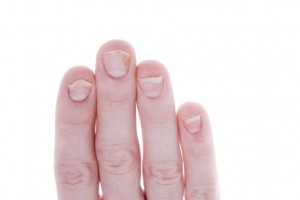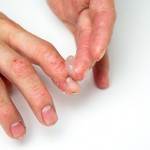

 Nail psoriasis and psoriatic arthritis symptoms have been found to be connected. Nail psoriasis is a condition in which the skin underneath the nails becomes affected by psoriasis, a skin disease. Developing both skin rash and nail psoriasis is quite common among the psoriasis patients, but having nail psoriasis alone is less common. In nail psoriasis, the roots where the nails grow become pitted and so people will grow ridging nails.
Nail psoriasis and psoriatic arthritis symptoms have been found to be connected. Nail psoriasis is a condition in which the skin underneath the nails becomes affected by psoriasis, a skin disease. Developing both skin rash and nail psoriasis is quite common among the psoriasis patients, but having nail psoriasis alone is less common. In nail psoriasis, the roots where the nails grow become pitted and so people will grow ridging nails.
Nail psoriasis can be an early sign of psoriatic arthritis. Previous research has found that at least 80 percent of people with psoriatic arthritis may also have nail psoriasis. A Canadian study looked at 188 people with psoriatic arthritis to determine if these changes to the nails were associated with specific joint symptoms. Of the group, 172 patients had some form of fingernail psoriasis on at least one nail.
Patients with blood spots under the nails known as splinter hemorrhages were found to have a higher number of swollen joints, compared to those with other nail psoriasis symptoms. The type of symptoms a patient had gave insight into what was happening with the joints. Researchers found that those patients with nail crumbling, separation of the nail from the skin under the nail, and a buildup of keratin under the nail were more likely to have a swollen or tender distal interphalangeal (DIP) joint on the same finger. DIP joint is the finger joint closest to the nail.
The researchers suggest that patients with psoriatic arthritis should have their fingernails examined.
Common changes to the nails that occur in nail psoriasis include:
 Psoriasis is caused by a combination of genetic, immunologic, and environmental factors. It is still not fully understood how nail psoriasis comes about, but it’s theorized that both forms have similar causes.
Psoriasis is caused by a combination of genetic, immunologic, and environmental factors. It is still not fully understood how nail psoriasis comes about, but it’s theorized that both forms have similar causes.
Psoriasis tends to run in families with at least 40 percent of psoriasis patients having a first-degree relative with the condition. If both parents have psoriasis, the risk of their child having it increases to 75 percent.
Signs and symptoms of nail psoriasis include:
Nail psoriasis treatment also involves healthy fingernail care. Here are some tips to maintain healthy nails.
Medical treatments for nail psoriasis include topical steroid creams for rubbing into the cuticle, steroid injections underneath the nail, removal of the nail, and oral medications. Antifungal medication may be needed as well if a fungus does develop.
 Along with proper fingernail treatment and medical intervention, here are some home remedies you can use to improve nail psoriasis.
Along with proper fingernail treatment and medical intervention, here are some home remedies you can use to improve nail psoriasis.
If you have psoriasis, speak to your doctor about your risk of nail psoriasis and have your fingernails checked regularly.
Psoriasis and psoriatic arthritis raises gout risk
Psoriasis and psoriatic arthritis increase the risk of gout, as both conditions are associated with the rising levels of uric acid, which breaks down into purines and causes gout. Uric acid builds up in small joints – usually the big toe – where it crystallizes and prompts sudden bouts of intense pain and swelling. If left untreated, gout can become a chronic condition and can contribute to joint damage over time. Continue reading…
Risk of aneurysm in the abdomen higher in psoriasis
A new study found that psoriasis patients are more likely to develop an aneurysm in the abdomen, compared to those without the autoimmune disorder. Although the risk is small, it is still important to note. The researchers also found that the risk of an abdominal aneurysm increases with the severity of psoriasis. The reason for this connection, researchers speculate, may have to do with the role of inflammation in both conditions. Continue reading…
Copyright © www.orthopaedics.win Bone Health All Rights Reserved